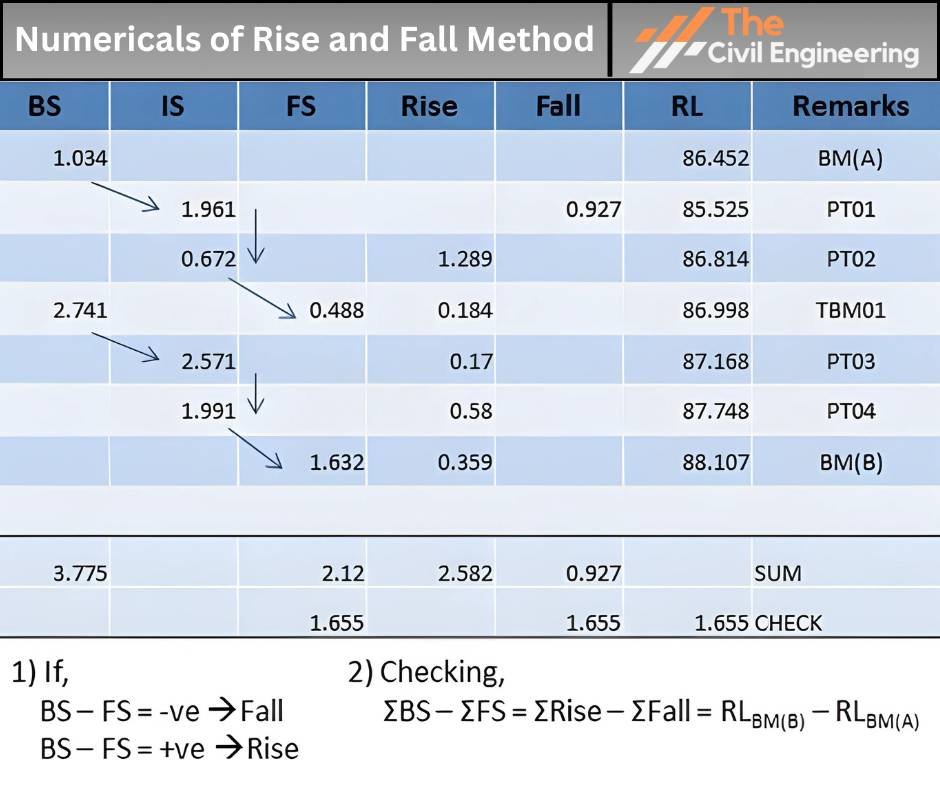The rise and fall method is the method of calculating the difference in elevation between consecutive points in leveling work.
Some of the points you have to know before starting numerical are:
a. Back sights:
The first reading after seeing the instrument is called Back Sights. This is taken at a known point like B.M or F.S. It is denoted as B.S.
b. Inter sights:
All readings taken between B.S and F.S are known as inter sights. It is denoted as I.S.
c. Fore sights:
The last reading after setting the instrument is known by foresight. It is denoted as F.S.
d. Benchmark:
Benchmark is a point with known elevation. It is denoted as B.M.
1. Steps in Numerical Calculation
a. Determine rise or fall using:
B.S – I.S or I.S – F.S
b. If:
B.S – F.S= +ve →Rise
B.S – F.S= -ve →Fall
c. Determine new RL:
New R.L = Old R.L – Fall = Old R.L + Rise
d. Arithmetic checking:
∑B.S – ∑F.S = ∑Rise – ∑Fall = Last R.L – First R.L
2. Numerical Examples of the Rise and Fall Method
Note: Tilt your mobile phone to view the full table
Question no. 1:
The following readings were observed successively with a leveling instrument. The instrument was shifted after the fifth and eleventh readings.
0.485, 1.210, 1.635, 3.395, 3.775, 0.650, 1.400, 1.795, 2.575, 3.375, 3.895, 1.735, 0.635, 1.605 m
Determine the R.L. of various points and show the entries in a level book, if the R.L. of the first point is 100m, using the rise and fall method.
Solution,
| Station | B.S | I.S | F.S | Rise | Fall | RL | Remarks |
| 1 | 0.485 | 100 | B.M | ||||
| 2 | 1.210 | 0.725 | 99.275 | ||||
| 3 | 1.635 | 0.425 | 98.850 | ||||
| 4 | 3.395 | 1.76 | 97.09 | ||||
| 5 | 0.650 | 3.775 | 0.38 | 96.71 | C.P.1 | ||
| 6 | 1.400 | 0.75 | 95.96 | ||||
| 7 | 1.795 | 0.395 | 95.565 | ||||
| 8 | 2.575 | 0.78 | 94.785 | ||||
| 9 | 3.375 | 0.80 | 93.985 | ||||
| 10 | 1.735 | 3.895 | 0.52 | 93.465 | C.P.2 | ||
| 11 | 0.635 | 1.10 | 94.565 | ||||
| 12 | 1.605 | 0.97 | 93.595 | ||||
| Total | 2.87 | 9.275 | 1.10 | 7.505 |
( Note: C.P. denotes Changing Point)
Arithmetic Check
∑B.S – ∑F.S = ∑Rise – ∑Fall = Last R.L – First R.L
2.870 – 9.275 = 1.1 – 7.505 = 93.595 – 100.00
– 6.405 = -6.404 = – 6.405
Hence checked.
Question no. 2:
The data from the survey are shown below. Use Rise and Fall method to reduce the data. Use arithmetic checks to support your answer.
| Station | Point | B.S | I.S | F.S | Rise | Fall | R.L | Remarks |
| 1 | TBM | 0.771 | ||||||
| 1,2 | A | 0.802 | 1.552 | |||||
| 2 | B | 2.311 | ||||||
| 2,3 | C | 3.580 | 1.990 | |||||
| 3 | D | 1.220 | ||||||
| 3 | E | 3.675 | ||||||
| 3,4 | F | 2.408 | 4.02 | |||||
| 4 | G | 0.339 | ||||||
| 4 | H | 0.157 | ||||||
Solution;
| Station | Point | B.S | I.S | F.S | Rise | Fall | R.L | Remarks |
| 1 | TBM | 0.771 | 43.000 | B.M | ||||
| 1,2 | A | 0.802 | 1.552 | (0.771-1.552) 0.781 |
(43.00-0.781) 42.219 |
C.P.1 | ||
| 2 | B | 2.311 | (0.802-2.311) 1.509 |
(42.219-1.509) 40.710 |
||||
| 2,3 | C | 3.580 | 1.990 | (2.311-1.990) 0.321 |
(40.710 +0.321) 41.031 |
C.P.2 | ||
| 3 | D | 1.220 | (3.580-1.220) 2.360 |
(41.031 +2.360) 43.391 |
||||
| 3 | E | 3.675 | (1.220-3.675) 2.455 |
(43.391-2.455) 40.936 |
||||
| 3,4 | F | 2.408 | 4.02 | (3.675-4.020) 0.345 |
(40.936-0.345) 40.591 |
C.P.3 | ||
| 4 | G | 0.339 | (2.408-0.339) 2.069 |
(40.591 +2.069) 42.660 |
||||
| 4 | H | 0.157 | (0.339-0.157) 0.182 |
(42.660 +0.182) 42.842 |
||||
| Total | 7.561 | 7.719 | 4.932 | 5.090 |
Arithmetic check:
1. Last R.L – First R.L = 42.842 – 43.000 = -0.158 m
2. ∑B.S – ∑F.S = 7.561 – 7.719 = -0.158 m
3. ∑Rise – ∑Fall = 4.932 – 5.090 = -0.158 m
Hence checked.
Question no. 3:
The following readings were taken with a level and 4m staff having initial B.M=100 m.
0.578, 0.933, 1.768, 2.450, 2.005, 0.567, 1.888, 1.181, 3.679, 0.612, 0.705, 1.810
The instrument is shifted after the 5th and 9th reading. Determine the R.L. of various points.
Solution,
| Station | B.S | I.S | F.S | Rise | Fall | R.L | Remarks |
| 1 | 0.578 | 100 | B.M | ||||
| 2 | 0.933 | 0.355 | 99.645 | ||||
| 3 | 1.768 | 0.835 | 98.81 | ||||
| 4 | 2.450 | 0.682 | 98.128 | ||||
| 5 | 0.567 | 2.005 | 0.445 | 98.573 | C.P.1 | ||
| 6 | 1.888 | 1.321 | 97.252 | ||||
| 7 | 1.181 | 0.707 | 97.959 | ||||
| 8 | 0.612 | 3.679 | 2.498 | 95.461 | C.P.2 | ||
| 9 | 0.705 | 0.093 | 95.368 | ||||
| 10 | 1.810 | 1.105 | 94.263 | ||||
| Total | 1.7578 | 7.494 | 1.152 | 6.889 |
Arithmetic check:
∑B.S – ∑F.S = ∑Rise – ∑Fall = Last R.L – First R.L
1.7578 – 7.494 = 1.152 – 6.889 = 94.263 – 100
-5.737 = -5.737 = -5.737
Hence checked.
Question no. 4:
The following readings (in meters) were taken with a leveling instrument using a staff of 4m long.
2.0, 2.5, 3.1, 3.9, 0.6, 1.3, 2.0, 2.8, 2.1, 3.1, 0.9, 3.0, 1.2, 2.3, 0.8
The instrument was shifted after the 4th, 9th, 11th, and 13th reading. The first reading was taken on BM of RL 100m. Calculate the RL of all points.
Solution,
| Station | B.S | I.S | F.S | Rise | Fall | R.L | Remarks |
| A | 2.0 | 100 | B.M | ||||
| B | 2.5 | 0.5 | 99.5 | ||||
| C | 3.1 | 0.6 | 98.9 | ||||
| D | 0.6 | 3.9 | 0.8 | 98.1 | C.P.1 | ||
| E | 1.3 | 0.7 | 97.4 | ||||
| F | 2.0 | 0.7 | 96.7 | ||||
| G | 2.8 | 0.8 | 95.9 | ||||
| H | 3.1 | 2.1 | 0.7 | 96.6 | C.P.2 | ||
| I | 3.0 | 0.9 | 2.2 | 98.8 | C.P.3 | ||
| J | 2.3 | 1.2 | 1.8 | 100.6 | C.P.4 | ||
| K | 0.8 | 1.5 | 102.1 | ||||
| Total | 8.9 | 6.2 | 4.1 |
Arithmetic check:
∑B.S – ∑F.S = ∑Rise – ∑Fall = Last R.L – First R.L
11 – 8.9 = 6.2 – 4.1 = 102.1 – 100
2.1 = 2.1 = 2.1
Hence checked.
This was for the rise & fall method.
3. References1. Content Filter & Authenticity Checking Team, Dream Civil International (Our team checks every content & detail to maintain quality.) |
Read More: Property Valuation: Fixation of Rent

